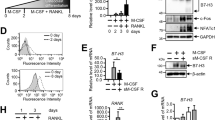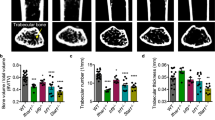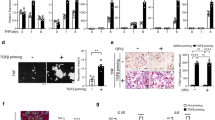Abstract
Bone metabolism results from a balance between osteoclast-driven bone resorption and osteoblast-mediated bone formation. Diseases such as periodontitis and rheumatoid arthritis are characterized by increased bone destruction due to enhanced osteoclastogenesis1,2. Here we report that interferon regulatory factor-8 (IRF-8), a transcription factor expressed in immune cells, is a key regulatory molecule for osteoclastogenesis. IRF-8 expression in osteoclast precursors was downregulated during the initial phase of osteoclast differentiation induced by receptor activator of nuclear factor-κB ligand (RANKL), which is encoded by the Tnfsf11 gene. Mice deficient in Irf8 showed severe osteoporosis, owing to increased numbers of osteoclasts, and also showed enhanced bone destruction after lipopolysaccharide (LPS) administration. Irf8−/− osteoclast precursors underwent increased osteoclastogenesis in response to RANKL and tumor necrosis factor-α (TNF-α). IRF-8 suppressed osteoclastogenesis by inhibiting the function and expression of nuclear factor of activated T cells c1 (NFATc1). Our results show that IRF-8 inhibits osteoclast formation under physiological and pathological conditions and suggest a model where downregulation of inhibitory factors such as IRF-8 contributes to RANKL-mediated osteoclastogenesis.
This is a preview of subscription content, access via your institution
Access options
Subscribe to this journal
Receive 12 print issues and online access
$209.00 per year
only $17.42 per issue
Buy this article
- Purchase on SpringerLink
- Instant access to full article PDF
Prices may be subject to local taxes which are calculated during checkout




Similar content being viewed by others
Accession codes
References
Wada, T., Nakashima, T., Hiroshi, N. & Penninger, J.M. RANKL-RANK signaling in osteoclastogenesis and bone disease. Trends Mol. Med. 12, 17–25 (2006).
Lee, S.K. & Lorenzo, J. Cytokines regulating osteoclast formation and function. Curr. Opin. Rheumatol. 18, 411–418 (2006).
Takayanagi, H. et al. Induction and activation of the transcription factor NFATc1 (NFAT2) integrate RANKL signaling in terminal differentiation of osteoclasts. Dev. Cell 3, 889–901 (2002).
Grigoriadis, A.E. et al. c-Fos: a key regulator of osteoclast-macrophage lineage determination and bone remodeling. Science 266, 443–448 (1994).
Kim, N., Takami, M., Rho, J., Josien, R. & Choi, Y. A novel member of the leukocyte receptor complex regulates osteoclast differentiation. J. Exp. Med. 195, 201–209 (2002).
Ishida, N. et al. Large scale gene expression analysis of osteoclastogenesis in vitro and elucidation of NFAT2 as a key regulator. J. Biol. Chem. 277, 41147–41156 (2002).
Kantakamalakul, W. et al. Regulation of IFN consensus sequence binding protein expression in murine macrophages. J. Immunol. 162, 7417–7425 (1999).
Nelson, N. et al. Expression of IFN regulatory factor family proteins in lymphocytes. Induction of Stat-1 and IFN consensus sequence binding protein expression by T cell activation. J. Immunol. 156, 3711–3720 (1996).
Driggers, P.H. et al. An interferon γ–regulated protein that binds the interferon-inducible enhancer element of major histocompatibility complex class I genes. Proc. Natl. Acad. Sci. USA 87, 3743–3747 (1990).
Tamura, T. & Ozato, K. ICSBP/IRF-8: its regulatory roles in the development of myeloid cells. J. Interferon Cytokine Res. 22, 145–152 (2002).
Marecki, S. & Fenton, M.J. PU.1/interferon regulatory factor interactions: mechanisms of transcriptional regulation. Cell Biochem. Biophys. 33, 127–148 (2000).
Holtschke, T. et al. Immunodeficiency and chronic myelogenous leukemia–like syndrome in mice with a targeted mutation of the ICSBP gene. Cell 87, 307–317 (1996).
Tamura, T., Nagamura-Inoue, T., Shmeltzer, Z., Kuwata, T. & Ozato, K. ICSBP directs bipotential myeloid progenitor cells to differentiate into mature macrophages. Immunity 13, 155–165 (2000).
Schiavoni, G. et al. ICSBP is essential for the development of mouse type I interferon–producing cells and for the generation and activation of CD8α+ dendritic cells. J. Exp. Med. 196, 1415–1425 (2002).
Zhu, C. et al. Activation of the murine interleukin-12 p40 promoter by functional interactions between NFAT and ICSBP. J. Biol. Chem. 278, 39372–39382 (2003).
Tsujimura, H. et al. Toll-like receptor 9 signaling activates NF-κB through IFN regulatory factor-8/IFN consensus sequence binding protein in dendritic cells. J. Immunol. 172, 6820–6827 (2004).
Zhao, J. et al. IRF-8/interferon (IFN) consensus sequence–binding protein is involved in Toll-like receptor (TLR) signaling and contributes to the cross-talk between TLR and IFN-γ signaling pathways. J. Biol. Chem. 281, 10073–10080 (2006).
Takami, M., Kim, N., Rho, J. & Choi, Y. Stimulation by Toll-like receptors inhibits osteoclast differentiation. J. Immunol. 169, 1516–1523 (2002).
O'Neill, L.A. How Toll-like receptors signal: what we know and what we don't know. Curr. Opin. Immunol. 18, 3–9 (2006).
Akira, S., Uematsu, S. & Takeuchi, O. Pathogen recognition and innate immunity. Cell 124, 783–801 (2006).
Takaoka, A. et al. Integral role of IRF-5 in the gene induction programme activated by Toll-like receptors. Nature 434, 243–249 (2005).
Azuma, Y., Kaji, K., Katogi, R., Takeshita, S. & Kudo, A. Tumor necrosis factor-alpha induces differentiation of and bone resorption by osteoclasts. J. Biol. Chem. 275, 4858–4864 (2000).
Kobayashi, K. et al. Tumor necrosis factor α stimulates osteoclast differentiation by a mechanism independent of the ODF/RANKL-RANK interaction. J. Exp. Med. 191, 275–286 (2000).
Kim, N. et al. Osteoclast differentiation independent of the TRANCE-RANK-TRAF6 axis. J. Exp. Med. 202, 589–595 (2005).
Lorenzo, J., Horowitz, M. & Choi, Y. Osteoimmunology: interactions of the bone and immune system. Endocr. Rev. 29, 403–440 (2008).
Takayanagi, H. et al. T-cell-mediated regulation of osteoclastogenesis by signalling cross-talk between RANKL and IFN-γ. Nature 408, 600–605 (2000).
Takayanagi, H. et al. RANKL maintains bone homeostasis through c-Fos–dependent induction of interferon-β. Nature 416, 744–749 (2002).
Mochizuki, A. et al. Identification and characterization of the precursors committed to osteoclasts induced by TNF-related activation-induced cytokine/receptor activator of NF-κB ligand. J. Immunol. 177, 4360–4368 (2006).
Koga, T. et al. NFAT and Osterix cooperatively regulate bone formation. Nat. Med. 11, 880–885 (2005).
Acknowledgements
We are grateful to M. Asagiri for technical assistance. We thank T. Kitamura (University of Tokyo) for providing the retrovirus expression system. We also thank A. Mochizuki and all members of the Department of Biochemistry, School of Dentistry, Showa University for valuable discussions. This work is supported in part by the High-Tech Research Center Project for Private Universities from the Ministry of Education, Culture, Sports, Science and Technology, Japan, 2005-2009, by Grants-in-Aid for Scientific Research from the Japan Society for the Promotion of Science (20390474 to M.T.) and by grants from the US National Institutes of Health (AR053843 and DE19381 to Y.C. and DE019420 and AR46713 to L.B.I.).
Author information
Authors and Affiliations
Contributions
B.Z. performed most of the experiments with substantial assistance from M.T. X.W. conducted the histological analysis. A.Y., T.K., X.H. and T.T. assisted with the experiments. K.O. provided the Irf8−/− mice. B.Z. and M.T. designed the project and wrote the manuscript. Y.C. provided recombinant RANKL and contributed to manuscript preparation. L.B.I. oversaw the bone marrow chimera and human cell experiments and contributed to manuscript revision. H.T. oversaw the inflammatory bone destruction experiments and provided crucial advice for the experiments. M.T. and R.K. supervised the project.
Corresponding author
Supplementary information
Supplementary Text and Figures
Supplementary Figures 1–7 and Supplementary Methods (PDF 343 kb)
Rights and permissions
About this article
Cite this article
Zhao, B., Takami, M., Yamada, A. et al. Interferon regulatory factor-8 regulates bone metabolism by suppressing osteoclastogenesis. Nat Med 15, 1066–1071 (2009). https://doi.org/10.1038/nm.2007
Received:
Accepted:
Published:
Issue Date:
DOI: https://doi.org/10.1038/nm.2007
This article is cited by
-
Recent advances of NFATc1 in rheumatoid arthritis-related bone destruction: mechanisms and potential therapeutic targets
Molecular Medicine (2024)
-
Suppression of IRF9 Promotes Osteoclast Differentiation by Decreased Ferroptosis via STAT3 Activation
Inflammation (2024)
-
Staphylococci planktonic and biofilm environments differentially affect osteoclast formation
Inflammation Research (2023)
-
Predicting the targets of IRF8 and NFATc1 during osteoclast differentiation using the machine learning method framework cTAP
BMC Genomics (2022)
-
Osteoclast biology in the single-cell era
Inflammation and Regeneration (2022)



